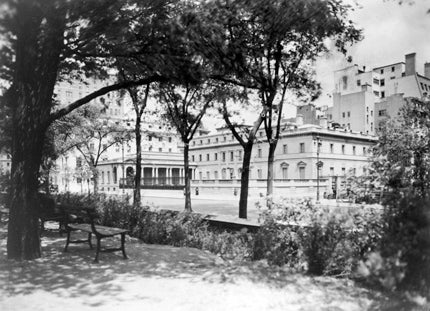From Mansion to Museum: The Frick Collection Celebrates
Seventy-Five Years
On view from June 22 through September 5, 2010
We have decided to preserve the Frick home as an example of a dwelling place of a man of means at the
beginning of the twentieth century. In time you will see the house itself will become of incalculable historic
value. We will keep the atmosphere. It isn’t a vast museum. It is a home containing magnificent French, Dutch
and Spanish paintings, Italian bronzes and Chinese porcelains.
—Director Frederick Mortimer Clapp,
The
New York Herald Tribune, December 3, 1933.
It was Henry Clay Frick’s (1849–1919) intention that his art collection and home at 1 East 70th Street be
opened as a museum following his wife’s death. After Adelaide Howard Childs Frick (1859–1931) died in
October 1931, the mansion, built in 1913–14 by Thomas Hastings (1860–1929), of Carrère and Hastings,
underwent further construction to transform it into a space suitable as a public institution. The photograph below shows The Frick Collection from Central Park in 1927.

Significantly
expanded by the architect John Russell Pope (1873–1937), the resulting building opened as The Frick
Collection to a fascinated public on December 16, 1935. Pope designed the classically inspired structure
that houses the Frick Art Reference Library as well. Located at 10 East 71st Street, the new Library had
opened to the public on January 14, 1935.
The four large-scale elevation drawings on view were executed for Pope’s office by the architectural
decorator and muralist Angelo Magnanti (1879–1969). They depict Magnanti’s proposed decorative
finishes for several of Pope’s new spaces at The Frick Collection, including the Reception Hall, Oval
Room, East Gallery, and Music Room. Magnanti’s designs were chosen from those submitted by nine
firms by a committee that included representatives from Pope’s office, the general contractor Marc
Eidlitz’s office, and the museum’s first director, Frederick Mortimer Clapp (1879–1969); the winning
designs were later given to Clapp as a gift from the artist. Magnanti’s previous work included the
decoration of the conference room of the United States Supreme Court building in Washington, D.C.,
and the Frick Art Reference Library’s Reading Room.
Also presented in this display is a recently acquired pen-and-ink drawing by Vernon Howe Bailey
(1874–1953) depicting the construction of the thirteen-story Frick Art Reference Library. Designed by
Pope and built between 1933 and 1934, this institution was a vital component of the Frick’s new building
campaign. |


